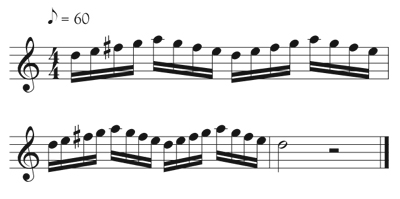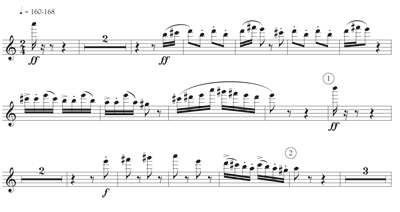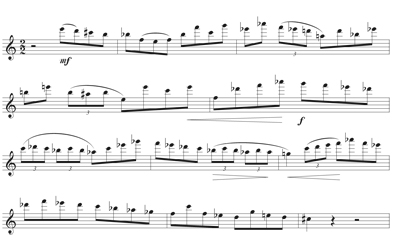Old pros will say that the two most important things in the performance of a piece are the first note and the last note. Beyond the obvious notion that these notes should sound the best, the ancient wisdom is that how a note starts defines the basic character of the musical idea, and the ending of a note tells the rest. Truly, the manner in which a musician starts notes is one of the most important aspects of playing. The ideal is to achieve the most variety possible. Attacking notes in a particularly energetic way also happens to benefit other aspects of a flutist’s playing.
Step One: Breath Attack
Play a second-octave quarter note with a sudden thrust of the air without using the tongue. This is called a breath attack. The diaphragm is engaged to increase the speed of the air.
Step Two: Adding the Tongue
Start by playing four tongued, staccato quarter notes in a row (preferably in the second octave) quarter note = 60 using the T attack. Repeat the four notes using the T attack and adding the sudden air pulse or breath attack in step one as if saying ha-ha-ha-ha without pronouncing the syllables.
Note that the notes in step one have a business-like, plain quality, while the notes in step two have an additional energetic and spirited nature. This happens because you are investing extra energy to play the notes, emerging from the most basic tonal element, the air itself.
Development
In order to develop this skill, practice breath attacks without using the tongue as if saying ha on each note. Before beginning the following practice suggestions, be sure the embouchure hole is aligned with your aperture. Use a mirror. Learn to lift the instrument to the embouchure in an efficient, organized and consistent manner. Hold the flute at a proper right angle to your head. Proper alignment is crucial to the immediate response of the tone when starting a breath attack.
Five-Note Scales
Play the following five-note scale on each ascending chromatic step with the breath attack, eighth note = 60. Play very rhythmically and staccato, and breathe in between the notes. Minimize movement of the embouchure throughout and keep the jaw and throat relaxed. Avoid any sound from the vocal chords or chewing motion in the jaw. Work to achieve good tonal focus and immediate response. Do not crack the notes in the second octave. Increase speed very gradually over time, using e =108 as a general goal. As you become proficient, repeat in the first octave.

As you become proficient, gradually add in the T attack (breath attack plus T attack). Try using different degrees of tonguing, from very light to a heavy accent. Take frequent breaks as the exercise is quite fatiguing. Varying the amount of the tongue attack helps achieve different emotional characterizations.
Larger Intervals
After mastering this approach on the five-note scale exercise, practice the technique using Marcel Moyse’s De La Sonorite pages 16-22. Once you are achieving consistent, good results, move on to Joachim Andersen’s Twenty-Four Progressive Studies for Flute, Op. 33, No. 2 and Twenty Instructive Studies, Op. 30, No. 3. Always play very rhythmically, breathing between the notes. Increase the tempo but make sure that the quality is still excellent. With practice, one can learn to play quite rapid passages of staccato notes with this attack, giving the music tremendous energy and buoyancy.
Energizer
The following well-known passages benefit greatly from this technique. On the following page, look at Francis Poulenc’s Sonata for Flute and Piano, movement 3. The single notes, both at the start and at #1, and all of the eighth notes in this passage can receive energized pulses of air with a firmly-tongued staccato. The accents in measures 9-10 will benefit greatly from this attack as well. Take care to start with a gentle attack in measure 11.
Francis Poulenc’s Sonata for Flute and Piano

In Paul Hindemith’s Sonate for Flute and Piano, movement 3, all of the tongued eighth notes can be enlivened by a subtle pulsing of the air column along with the articulation. This results in a high level of excitement for the entire movement. The eighth notes should be long, as staccatos will sound rather mechanical.
Paul Hindemith’s Sonate for Flute and Piano

In Carl Nielsen’s Concerto for Flute and Orchestra, movement 1, keep the air column alive with the staccato articulations to project the character of a scherzo. A little vibrato on the accents also helps. Small groups of notes also come to life using this technique.
.jpg)
In Philippe Gaubert’s Nocturne et Allegro scherzando, measures 53-61, give the sixteenth and eighth note groups a little pulse of air with the articulation each time for the scherzando feel and a high level of rhythmic definition. A bit of vibrato really boosts the energy.
.jpg)
In this passage from Alphonse Duvernoy’s Concerto for Flute and Orchestra, Op. 45, Measures 7-10, the tenuto notes and accented neighboring tones can have a very warm, expressive pulse of air, with vibrato, using a very gentle tongue with the attack.
.jpg)
Learning to start the notes with the air itself benefits your playing in many ways. It aids with basic focus, develops embouchure strength and stability, produces a higher sensitivity to air placement, and helps develop firmer control over air flow and vibrato as well.






